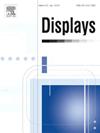The interaction efficiency of different visual areas on a virtual reality interaction space: Standing versus sitting posture
IF 3.7
2区 工程技术
Q1 COMPUTER SCIENCE, HARDWARE & ARCHITECTURE
引用次数: 0
Abstract
User posture and visual area can impact searching-selecting efficiency, thereby influencing interaction efficiency. Virtual Reality (VR) devices extend the traditional two-dimensional interface to a three-dimensional interaction space, requiring users to alter their body postures when using them. This study compared the searching-selecting efficiency of different postures (standing and sitting) and visual areas in a VR environment. An experiment measured thirty-five participants’ searching and selecting times for targets under different conditions. A two-way analysis of variance (ANOVA) indicated that the interaction efficiency was generally higher for participants in a sitting posture than in a standing posture. Participants spent less time searching for left side targets than in other visual areas. However, the interaction effect between posture and visual area was not significant. These results suggest that posture and visual areas respectively influence searching-selecting efficiency in VR environments. These findings could provide insights for VR developers to enhance interaction design, particularly interface design, for different user postures, thus supporting interaction efficiency and user experience.
求助全文
约1分钟内获得全文
求助全文
来源期刊

Displays
工程技术-工程:电子与电气
CiteScore
4.60
自引率
25.60%
发文量
138
审稿时长
92 days
期刊介绍:
Displays is the international journal covering the research and development of display technology, its effective presentation and perception of information, and applications and systems including display-human interface.
Technical papers on practical developments in Displays technology provide an effective channel to promote greater understanding and cross-fertilization across the diverse disciplines of the Displays community. Original research papers solving ergonomics issues at the display-human interface advance effective presentation of information. Tutorial papers covering fundamentals intended for display technologies and human factor engineers new to the field will also occasionally featured.
 求助内容:
求助内容: 应助结果提醒方式:
应助结果提醒方式:


